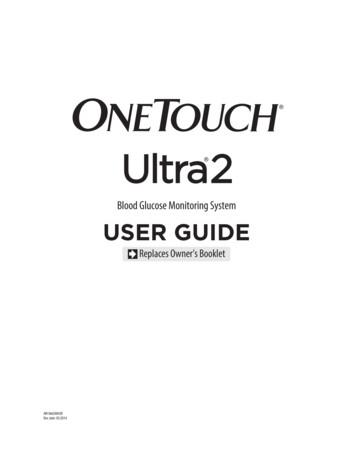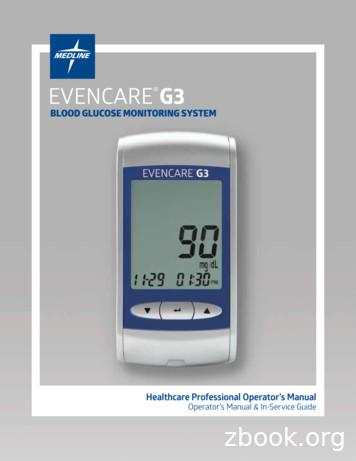Blood Glucose Homeostasis
Blood Glucose HomeostasisMedical BiochemistryDepartment2015
Blood Glucose Concentration Fasting blood glucose (8-12 hrs)70-110 mg/dL It rises to 140 mg/dl after meal(post prandial).
Regulation of blood glucoseThe concentration of blood glucose level ismaintained constant bythe action of two general opposing factors:The rate of glucose enterance to the bloodRate of removal of blood glucose
GlycogenolysisGluconeogenesisDietBlood GlucoseFasting 70-110mg/dlPostprandial 140mg/dlProduction ofenergy by alltissuesLipogenesisGlycogenesis
Regulation of Blood GlucoseSeveral factors are important for regulating bloodglucose level:I. Regulation by differenttissues and organsLiver and Extrahepatic tissue(Kidney, Gastrointestinal tract,Skeletal muscle, adipose tissue)II. Hormones
Gastrointestinal tractIt controls the rate of glucose absorptionIt protects the body from sudden andexcessive increase in blood glucoseby different ways:
The gradual evacuation of gastric contentsallows good time for absorption andutilization of glucose.
Thesecretionofgastro-intestinalhormones, stimulate insulin secretion byB-cells of pancrease.Insulin is secreted to portal blood beforeabsorption of glucose, So, Glucose givenorally stimulates more insulin thanintravenous glucose.
Glucose uptake by differenttissuesThis is mediated through differentprotein transporter (GLUT4) which isinsulindependentinskeletalmuscles, heart and adipose tissues.
LiverThe liver is the main organ responsible forglucose homeostatic mechanisms.The uptake or output of glucose by liver cells isdirectly related to blood glucose level.
Glucose is only metabolized in livercells when its level in blood isincreased.Due to low affinity of glucokinase toglucose, and its induction by insulin.
If blood glucose level increases, the livercontrols this elevation and decreases it through:Oxidation of uconeogenesis.If blood glucose level decreases, the liver controlsthis drop and increases itThe reverse occurs
Kidney All glucose in blood is filtered through the kidneys, itthen completely returns to the blood by tubularreabsorption.So, Normally urine is free from Glucose
Renal threshold 180 mg/dL
If blood glucose exceeds a certain limit (renalthreshold) or if the renal threshold isabnormally low (renal glucosuria), it willpass in urine causing glucosuria. Renal threshold: it is the maximum rate ofreabsorption of glucose by the renal tubules. Normally the renal threshold for glucose is 180mg/dL.
Adipose TissueThey play an important role in glucosehomeostatic mechanisms.If blood glucose level increases, decreases itthroughThe uptake of glucose by tissuesGlucose oxidationLipogensis.
During fasting or carbohydrate deficiency,Glucose uptake and ssuesforproduction of energy (spare blood glucose)Increase oxidation of fatty acids in liver gluconeogenesis and --- glycolysis.GlycerolSubstrate for gluconeogenesis
Skeletal muscle During carbohydrate feeding,the uptake of glucose.glucose oxidationglycogensis.
During fasting,The muscles can oxidize fatty acids andketone bodies instead of glucose forproduction of energy.
The amino acids released from muscles(especially alanine) are utilized assubstrarte for gluconeogenesis in liverglucose-alaninecycle
Lactate produced during severe muscularexercise is used as substrarte forgluconeogenesis in liverCori cycleOrglucose –lactate cycle
Hormonal regulating of sGHThyroid hormones
Hormonal regulating of blood glucoseInsulin: leads to decrease of blood glucose levelGluconeogenesisGlucose entrance to the cells and oxidation.glycogenesis(ms & liver)---GlycogenolysisLipogenesis ---------------------Protein synthesisKetogenesislipolysis
AdrenalineGluconeogenesisGlycogenolysis ----------- glycogenesisInsulin secretion.GlucagonGluconeogenesis(in the liver only)Glycogenolysis -------glycogenesis
Glucocorticoids Gluconeogenesis Facilitate the action of glucagons,adrenaline and growth H.
Growth hormone Glucose uptake by the tissues.Lipolysis which FFA leading toglucose utilization (glucose sparingeffect)
Variations in normal blood glucoseHyperglycemia 110 mg/dlHypoglycemia 70mg/dl
Def.HyperglycemiaIt is the rise of blood glucose level abovethe normal level. Causes Deficiency of insulin: Diabetes mellitus. Pancreatictomy (total or subtotal).
Increase of anti-insulin hormones: Adrenaline as in emotion or in case ofpheochromocytoma Glucocorticoids as in adrenal tumorsand Cushing syndrome. Thyroxin as in hyperthyroidism. Pituitarygrowthacromegally.hormoneasin
Def.HypoglycaemiaIt is the decrease in blood glucose levelbelow the fasting level. Classified into Fasting Hypoglycaemia (occurs as a response tofasting for 12 – 16 hr). Reactive hypoglycaemia (Hypoglycaemia due tosome other stimuli)
Causes of fasting hypoglycaemiaoInsulinomao Non-pancreatic tumours (usually mesodermal)o Liver disease of various typeso Hypoadrenalismo Hypopituitarismo Glycogen storage diseaseso Neonatal hypoglycaemiao Idilopathic hypoglycaemia of childhood.
Causes of reactive (or stimulative)hypoglycaemiao Drug-induced, due to insulin, oral hypoglycaemicagents (e.g. tolbutamide), also to dietary constituents e.g.alcohol, L-leucine.o Essential reactive hypoglycaemia, in whichsymptoms occur 2-4 hr after a meal, probably due to anexaggeration of the normal insulin response to carbohydrateingestion.o Galactosaemia.o Hyereditary fructose intolerance.
GlucosuriaDef.Presence of detectable amounts of glucosein urine ( 30 mg/dL).Causes:A.Hyperglycemic glocusuriaB.Normoglycemic or renal glucosuria
Hyperglycemic Glucosuria Blood glucose exceeds the renal threshold (180mg/dL). It is caused by:1. Diabetes mellitus.2. Emotional or stress glucosuria(epinephrine glucosuria)1. Alimentary glucosuria;It is due to increased rate of glucose absorption as in cases ofgastrectomy or gastrojejunostomy.
Normoglycemic renal glucosuria1. Congenital renal glucosuria: due to congenitaldefect in renal tubular reabsorption of glucose.2. Acquired renal disease (e.g. nephritis).3. Pregnancy: due to decreased carbohydrate toleranceand renal threshold in the later months of pregnancy.4. Injection of phlorhizin due to inhibition of the(SGLUT) in renal tubules.
Dr. Manal El Desoky
The concentration of blood glucose level is maintained constant by the action of two general opposing factors: The rate of glucose enterance to the blood Rate of removal of blood glucose Regulation of blood glucose. Blood Glucose F
The Dario Blood Glucose Test Strips are for use with the Dario Blood Glucose Meter to quantitatively measure glucose (sugar) in fresh capillary whole blood samples drawn from the fingertip. The Dario Glucose Control Solutions are for use with the Dario Blood Glucose Meter and the Dario Blood Glucose Test Strips to check that the meter and test
A blood glucose meter uses blood glucose test strips to mea-sure the blood glucose level of a diabetic patient. The mea-surement is quick and only requires a small amount of blood. The measured value is recorded in a blood glucose meter which also contains blood glucose data from previous measurements [1-4]. The reaction zone on the electrode of
Glucose High: 600 mg/dL The Livongo meter can measure blood glucose accurately from 20 mg/dL to 600 mg/dL. If your blood glucose is higher than 600 mg/dL, the screen will display this message. Please call your Doctor if you receive this message. Glucose Low: 20 mg/dL Livongo meter can measure blood glucose accurately from 20mg/dL to 600 mg/dL.
The glucose testing is based on the measurement of electrical current generated by the reaction of glucose with the reagent of the strip. The meter measures the current, calculates the blood glucose level, and displays the result. The strength of the current produced by the reaction depends on the amount of glucose in the blood sample
Both type 1 and 2 diabetics can monitor their blood-glucose with a home glucometer and test strips. It is estimated that glucose biosensors are 85% of the total biosensor market.(3-5) When a person with diabetes makes blood-glucose measurements at home, their results are used to
Glucose in the blood sample mixes with special chemicals in the test strip and a small electric current is produced. The strength of this current changes with the amount of glucose in the blood sample. Your meter measures the current, calculates your blood glucose level, displays the result, and stores it in its memory.
EVENCARE G3 QUALITY CONTROL LOG 24 BLOOD GLUCOSE SYSTEM PERFORMING A CONTROL SOLUTION TEST WITH VIAL STRIPS 25 BLOOD GLUCOSE SYSTEM PERFORMING A CONTROL SOLUTION TEST WITH FOIL- WRAPPED STRIPS 26 . Calibration: Plasma Test Time: 6 seconds Sample Size: Minimum 0.8µL . be completed before the meter will perform a blood glucose test. Step 3.
Artificial intelligence (AI) technologies are developing apace, with many potential ben-efits for economies, societies, communities, and individuals. Realising their potential requires achieving these benefits as widely as possible, as swiftly as possible, and with as smooth a transition as possible. Across sectors, AI technologies offer the promise of boosting productivity and creating new .























